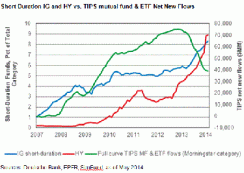Not unlike last year, when inflation-protected bond markets witnessed unexpectedly extreme volatility from May to July — at that point, to the downside — catching many investors flat-footed, the price action of Treasury Inflation-Protected Securities (TIPS) in the first half of 2014 has surprised many, this time with its strength. That is largely because at the end of 2013 overwhelming market consensus suggested that taking duration risk would be dangerous in the year ahead, as yields appeared poised to move higher. As it turned out, that consensus was wrong — or at least its timing was off — and long-duration assets have turned out to be one of the best-performing areas of the fixed-income markets so far this year. Indeed, the Barclays Capital U.S. TIPS Index has delivered a 5.67 percent year-to-date total return, through May 29, greatly outpacing market participant expectations at the start of the year.
In December 2013 BlackRock published an Global Market Thought Leaders article that examined in detail TIPS valuations at the longer end of the yield curve. At that time, rather than encouraging investors to shy away from duration in the real-rate segment, we suggested they actually look for opportunities to embrace long-forward real-rate exposure as it ventured north of 2 percent. Such a position would have worked very well for investors so far in the first half of 2014. But as we approach midyear, we thought it would be useful to assess recent developments in rates and TIPS markets and, in a manner of speaking, “mark-to-market” our views, given the change in recent valuations along the yield curve.
In light of the complexity of market dynamics this year, it’s time to address what’s behind rate-market price action. (In a subsequent article, coming later this month, we will examine TIPS market valuations and related themes.) So far in 2014, the price action at the longer end of the yield curve has been driven by several events, some economic and some not. In no particular order, we will elaborate on each factor that we believe has been vital to this unexpectedly dramatic rally in rates.
1) Portfolio Positioning. As we mentioned, duration was the unwanted risk factor within the fixed-income market in the second half of 2013, and consequently, capital flows out of long-dated benchmarked portfolios and into short-dated products were dramatic (see chart). The violence in price action that started in spring 2013 illustrated a meaningful positioning shift, as investors shunned long-duration assets out of fear that there was a lot more volatility to come as the Federal Reserve tapered its quantitative easing (QE) program and eventually shifted interest rates away from the near-zero range. More recently, of course, some of this position shift has reversed.

2) Scarcity of Assets and Unconventional Monetary Policy. Despite the Fed’s tapering, net fixed-income issuance continues to decline, whereas the need for yielding assets in a postcrisis world continues to grow. In our view, demographic trends unfolding over decades dictate that the need for fixed-income assets will not go away and, when that factor is combined with the continued reinvestment needs of portfolios across the globe, any meaningful setback in rates should be welcomed by those who have cash to put to work. Moreover, even as the Fed continues to taper its QE program this year, the Bank of Japan is still buying assets at an extraordinary level, and the prospect that even the European Central Bank may enter into its own QE program has, without question, contributed to a grab for yield this year and a rally in rates markets.
3) Greater Institutional Demand. Demand from pension fund and insurance companies for fixed income, although difficult to accurately quantify, is nevertheless likely to continue to grow in the coming year given the powerful equity market performance enjoyed since 2009, the lurch to higher interest rates in the second half of 2013 — particularly at the long end of the curve — and the fantastic opportunity these organizations have to derisk portfolios and defease liabilities.
4) The Drop-Off in Economic Growth. In stark contrast to inventory-induced strength in the latter half of 2013, the latest estimate of first-quarter real GDP in the U.S. is a dramatically disappointing negative 1 percent, revised downward from a modestly positive 0.1 percent. The harsh winter weather was a significant issue during the first quarter of 2014 across stretches of the U.S., yet it is very hard to quantify the exact economic impact of the persistently extreme cold and heavy snow. Anecdotally: Nearly 50,000 flights in the U.S. were canceled in January, so it is plain that economic consequences are very real.
A subcomponent of the economic slump is a housing market that appears to be on a weaker footing in 2014 than at this time last year. The weather obviously had an impact on the housing market too. But buying a home has crept further out of reach, with higher mortgage rates, elevated home prices and constrained supply beginning in the latter half of 2013. When you combine that with a lower rate of new household formation, investor optimism with respect to continued strength in the housing sector took a hit. Despite housing’s being a small contributor to GDP growth relative to history, the knock-on effects of a strong and healthy housing market are profound, as new homeowners rush to furnish homes, purchase appliances and so on. A strong housing market was definitely something investors had pinned their hopes on in 2014, and the apparent weakness has caused many to reassess their view.
5) Geopolitical Concerns. The unrest in Ukraine has also led some managers to shift their allocations toward higher-rated bonds — not only from a flight-to-quality perspective but also from the potential impact that retaliatory sanctions leveled against Russia may have on European growth prospects. For example, a cessation of Russian natural gas exports to Europe would have significant implications for a region just now emerging from a major financial crisis.
6) Lower Terminal Fed Funds Rate. Increasingly, a convincing case can be made for the idea that there is less long-term structural growth potential in the developed world than in the past. If that’s the case, the terminal fed funds rate (or neutral rate) should also be lower than it has been historically. This argument has gained momentum in recent months. Not only has former Fed chair Ben Bernanke mentioned it, but so have current Fed governors, such as New York Fed president and CEO William Dudley in a May 20 speech. These comments have had a powerful impact on market valuations, adding fuel to fire the rate rally, as a lower-than-expected terminal fed funds rate is priced into the term structure.
It is very hard to decipher how much each of these factors has influenced the move in rates this year, since all have been important at various points. But it is extremely hard to ignore the powerful impact that a potentially lower long-term policy rate has had recently, as the rhetoric has picked up against a backdrop of improving economic data. As we argued at the end of 2013, the potential for structurally lower economic growth was a key reason we were reasonably comfortable holding long-duration assets.
Still, given the moves that we have seen in rates markets since then, how does current market pricing and forward-rate structure valuations fit with the thesis of a lower terminal fed funds rate? We will turn to that question, as well as how secular factors are playing into our inflation views, in our next piece, later this month.
Martin Hegarty, managing director, is head of BlackRock’s inflation-linked bond portfolio management team within the institutional multisector group in New York.
Get more on fixed income.






